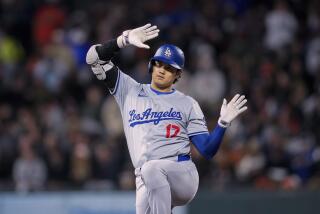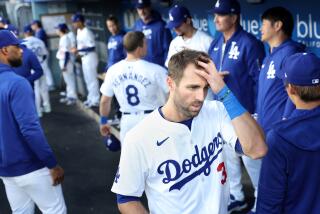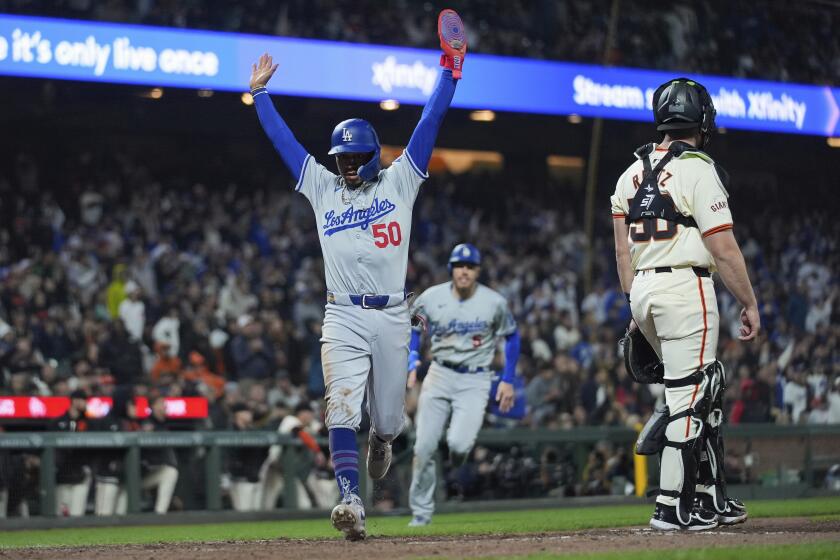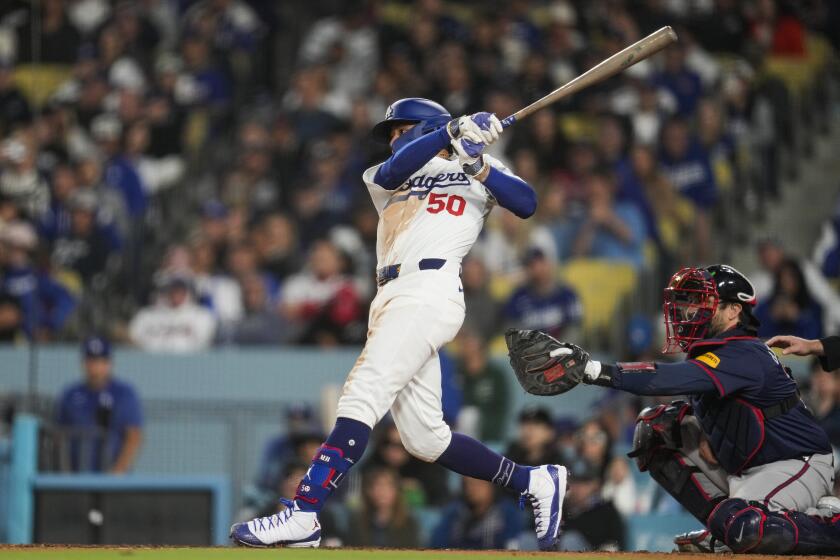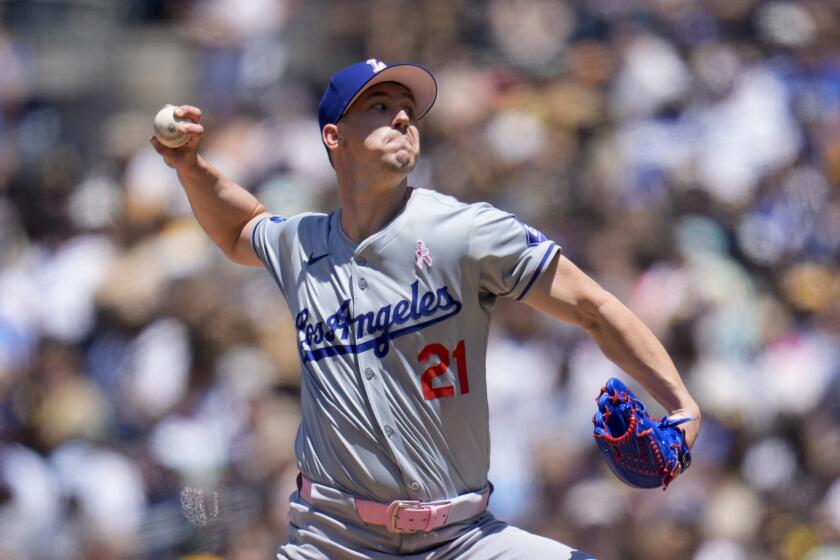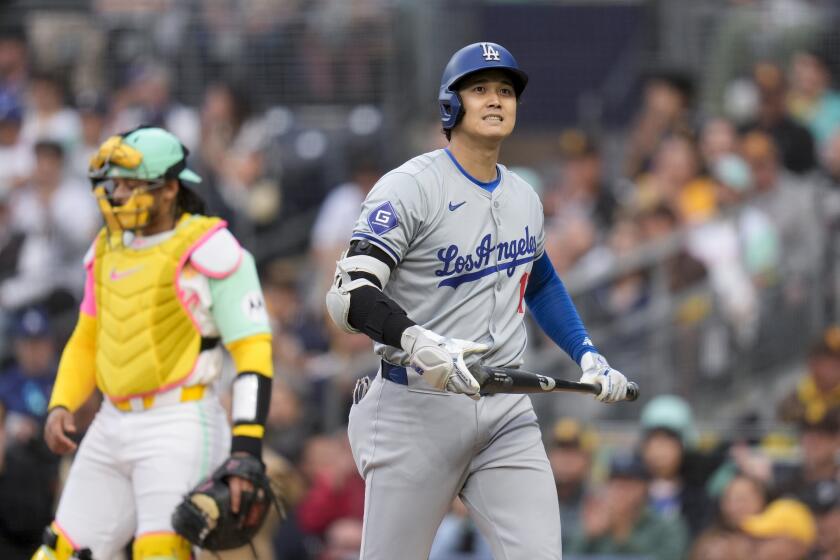SPRING FEVER : Guerrero Has Gotten the Jump on a Season of Great Challenge
He stood at the edge of the runway, watching the charter airliner slowly taxi toward the terminal. When the door opened and the first Dodger got off, Pedro Guerrero was at the foot of the stairs, offering greetings with a smile as bright as the gold medallion around his neck.
So many times before, Guerrero had kept the Dodgers waiting for his spring arrival. But this time, as if the irony of his unseasonably early appearance needed underlining, Guerrero decided to lead the welcoming party for his teammates here last Thursday.
What a startling sight it must have been to the other players. They no doubt had heard the news of Guerrero’s reporting, but actually seeing him must have seemed as unusual as finding a swallow spending the winter in San Juan Capistrano.
Given Guerrero’s history, some cynics among them might even have been wondering whether the Dodger slugger was early for this spring training or late for last.
Guerrero reported two days before anyone else not because he ran out of inventive excuses to justify his tardiness, such as an expired passport or real estate hassles or a bad cold.
“I’m here because of what happened last year,” Guerrero said.
On the final day of spring training last year, Guerrero tore a tendon in his left knee in an aborted slide at third base. The injury, which has ended more than one athlete’s career, required surgery and months of rehabilitation. Although Guerrero hobbled back into the lineup in late summer, the Dodger season had long since been trashed.
Since a healthy Guerrero means about 30 home runs, 90 runs batted in and a .300 average, the Dodgers strongly suggested that it would be a good idea for Guerrero to report this spring with the pitchers and catchers--roughly two weeks before his customary arrival.
Surprisingly, Guerrero agreed. And in the first three days of spring training, Guerrero appears to have not just an improved left knee but a better attitude as well.
He looks fit, although he still is running a little tentatively, and Guerrero says it will take most of the spring to regain his timing at the plate and confidence in the outfield. Even so, Dodger Manager Tom Lasorda is impressed already.
“Just to see him here is very, very important to this team,” Lasorda said. “That’s a tremendous change just in itself.”
The change in Guerrero’s attitude is much easier to notice, though. Guerrero, accompanied by Lasorda, arrived here last Wednesday night and twirled pasta with a group of sportswriters, who haven’t been his favorite people.
The next afternoon, Guerrero and Lasorda ran on the beach and then went to the airport to greet the Dodger charter.
“When Tommy invited me to come that early, I thought he was teasing,” Guerrero said, laughing at himself. “But then I realized he was serious. I thought it was a good idea because I wasn’t doing anything but lifting weights (at home in the Dominican Republic). I thought I’d need more time to get my things together. That’s one reason why I’m here. Plus, I didn’t play much.”
He appeared in 31 games last season, but most of his appearances were either as a pinch-hitter or as a left fielder who covered no more ground than was absolutely necessary. After a brief comeback in early August, in which he went 0 for 7 and had an embarrassing time chasing a fly ball in a nationally televised game against Houston, Guerrero returned for good in September, finishing the season with a .246 batting average and 5 home runs.
Although Guerrero, technically, did have that little comeback late last season, this will be the season the Dodgers and others find out whether he really is the same type of player who carried the Dodgers to the 1985 National League West championship.
“This guy is an awesome player, let’s not forget that,” Lasorda said. “He makes an impression, positive or negative, on all of us. Let’s sum it up in this way: If you’re an advertising firm and you lose the IBM account, it affects you hard.
“The guy hit 33 home runs (in 1985), and he’s one of the select few players who can carry a club. So when he went down, we lost a real big part of our club. Then, it was like the domino theory. A lot of other guys went down.”
No one, however, went down as hard or as severely as Guerrero did last April 3 at Holman Stadium here.
Sitting in the dugout, not even 20 feet from the scene of his injury, Guerrero couldn’t help but be reminded of that fateful day. But despite reporters’ questions, he did not want to talk about it. In sight, but out of mind, he seemed to be saying.
“I have forgot about (the injury),” Guerrero said. “Like today, when I walked over here from the clubhouse, I never even thought about it. That’s the past. I don’t even care to talk about it. That is the only question I get from writers and people. How are you feeling? How’s the injury? You get tired of hearing it.”
Still, the questions and the topic are inevitable. His first night in town, the owner of the Italian restaurant where Guerrero dined walked over to the table, thanked him for coming and gave him the following food for thought: “Just don’t slide anymore!”
Actually, Guerrero has claimed all along that he had decided not to slide into third base on the play. He said he simply caught his spike in the dirt trying to stop and put too much pressure on the knee.
Sliding has long been risky for Guerrero, whose many baseball skills apparently do not include that one. In 1977, for instance, Guerrero broke his left ankle sliding into second base while trying to break up a double play. Then in 1980, sliding into second base on a pick-off play, he injured ligaments in his left knee. When he changed to a head-first slide, he persistently jammed his shoulder and had to give that up.
“Pete doesn’t know how to slide well,” Lasorda said. “But Pete’s got to realize that he didn’t hurt himself because he didn’t know how to slide. It was indecision on his part that caused the injury.”
Except for gratuitous sliding, Guerrero says he won’t hold back anything this spring. But he also says you shouldn’t expect too much too soon.
“I don’t know how the knee will be until I really start working out a little harder,” Guerrero said on his first day at Dodgertown. “This is just the second time I’ve hit since the season was over. I don’t think it will take me long. Plus, I have a lot of time this year.”
Guerrero’s confidence apparently was unaffected by his knee injury and the long recovery. “The only thing I worry about is stealing bases,” he said. “Hitting, I’m not worried about. I don’t think I’ll have to steal many bases. I don’t feel any pain at all, even when I’m working out on the knee. All I know is that it feels pretty good.”
That took some doing, though. In the reconstructive surgery, Dr. Frank Jobe reattached the patellar tendon, which runs from above the kneecap, to the shinbone. After that came five months of therapy supervised by Pat Screnar, the Dodgers’ physical therapist.
For the first six weeks, Guerrero’s leg was in a cast but he still did isometric exercises and had electrical stimulation to prevent extreme atrophy. Eventually, Guerrero started exercising with weights, then a more strenuous walking program and, when the range of motion in the leg improved, did work on a stationary bike.
It was, Screnar said, a monotonous and difficult rehabilitation. But he said that Guerrero worked hard and made every trip with the team so that Screnar could supervise his program.
On May 21, Guerrero began taking batting practice in the indoor cage adjoining the Dodger clubhouse. But it was months before he could run.
“He knew he had to work to even have a chance to play at all last season,” Screnar said. “It’s a tribute to him that he could play. Conceivably, somebody could have missed the entire season. I know a lot of people expected him to.”
Screnar said Guerrero’s injury was not career-threatening, but that’s not to say it wasn’t serious.
Dennis Leonard, recently retired Kansas City Royal pitcher, suffered the same injury as Guerrero and needed four operations before he could resume playing. He was never the same. Although Wilt Chamberlain missed only four months after surgery on a ruptured patellar tendon, Clipper guard Norm Nixon will miss the entire season with the same injury.
Screnar said each case has to be judged separately, based on severity and the condition and activity of the individual.
“Dennis Leonard had a lot more complications than Pete and recurrent surgery,” Screnar said. “We knew all along Pete would recover eventually. We never considered it career-threatening.”
Still, recovery was not easy for Guerrero. Eager to return, his name was taken off the disabled list Aug. 1, then put back Aug. 10 after his succession of frustrating performances. Twice, he was brought in to pinch-hit with the bases loaded and failed to produce. His one start in left field was painful for people to watch. He lasted four innings before injuring a muscle above the left knee. Compared to that, his September return was a raving success.
Those close to Guerrero say he was depressed most of the time during the 1986 season. Although his attitude toward rehabilitation was good, his general attitude was not.
Now, without emotion or much elaboration, Guerrero says the 1986 season was frustrating.
“Last year was tough,” he said. “I hope I don’t have to go through those things again. That’s another reason why I’m here early. I need to be ready.”
Ralph Avila, a Dodger special assignment scout and confidant to the club’s Dominican players, says the 1986 ordeal affected Guerrero in a positive way.
Avila’s opinion is that, at 30, Guerrero finally matured.
“He stayed away from the parties and the lights, if you know what I mean, this winter,” Avila said. “Pete’s grown up a lot. Last year was a hell of an experience.
“One thing people don’t realize is that American people mature earlier than Latins. In Latin America, someone 24 or 25 is a baby. A real man , the words we use, isn’t until about 27 or 30.
“Me, I love the guy. I think Pedro is one of the greatest persons in the world. He takes care of his family and his friends. But he can sometimes also be the worst person in the world.
“In Santo Domingo, Pedro was allowed to do whatever he wanted because he was a great baseball player. He didn’t realize he did it the wrong way. He thought he was supposed to act the way he did.”
Now that he is one of the oldest Dodgers, both chronologically and in years of service, as well as the second-highest paid, behind Fernando Valenzuela, Guerrero talks of developing leadership qualities.
“I think I can be a leader, but I don’t think I have the responsibility to be,” Guerrero said. “I know I have to help whoever needs help and play the way the game’s supposed to be played. . . . I’m 30 years old and I think more and I don’t do the things I did, oh, like last year.”
And, what are those things?
“I’d rather keep that to myself,” Guerrero said, laughing.
Responsibility or no, Guerrero is a role model to many of the Dodgers’ Latin players, especially close friend Mariano Duncan.
Said Lasorda: “I talked to him about that. There are certain players who are capable of becoming (leaders), but only a few do it. In most cases, the ones who do lead by example. If Pete just goes out there and plays hard and has a good attitude, he will be a leader without having to say anything.”
Maybe it was the injury or just the realization of turning 30, but Guerrero has suddenly discovered his mortality. The swagger is still in his walk, but now he talks about how many years he might have left in baseball.
“When I was 24, I used to say that it’s a long way to get to 30,” Guerrero said. “But it seems like it came so fast. Now, I feel like a real man. Age can change a lot of people. Maybe now, I have to keep myself in better shape than when I was 25. Your body keeps changing, but I try to be the same.”
If nothing else, at least Guerrero has changed his spring training timetable.
“You know, I never thought I came late at all,” Guerrero said. “Because when somebody goes late to spring training, they get fined. I never got fined. The only thing was that everybody else got here before me.”
Guerrero, who had talked freely for 15 minutes, also didn’t want reporters to get the impression that he had changed his reluctance to be interviewed.
So, during a lull in the questioning, he stood up and grabbed his batting helmet.
“No more questions? OK, go to hell, then.”
Dodger Notes Todd Maulding, the Dodger bullpen catcher, was struck in the left eye by a pitch thrown by Tim Leary during morning drills Monday and was taken to a local hospital for observation. Maulding was not wearing a mask. . . . The Dodgers said that they will open a baseball academy in the Dominican Republic March 21. The academy will feature two baseball fields, a dormitory, dining room, clubhouse and training facility. Dodger special assignment scout Ralph Avila will run the academy.
More to Read
Are you a true-blue fan?
Get our Dodgers Dugout newsletter for insights, news and much more.
You may occasionally receive promotional content from the Los Angeles Times.
